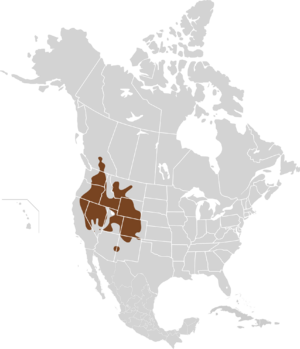Montane vole facts for kids
Quick facts for kids Montane vole |
|
|---|---|
 |
|
| Conservation status | |
| Scientific classification | |
| Genus: |
Microtus
|
| Species: |
montanus
|
 |
|
The montane vole (Microtus montanus) is a small rodent that looks a bit like a mouse. It's a type of vole that lives in the western parts of the United States and Canada. These little creatures are an important part of their mountain homes!
Contents
What Does a Montane Vole Look Like?
Montane voles are medium-sized voles. They usually grow to be about 14 to 22 centimeters (about 5.5 to 8.5 inches) long. This measurement includes their tail, which is about 2 to 7 centimeters (1 to 3 inches) long.
Adult voles typically weigh between 37 and 85 grams (about 1.3 to 3 ounces). Male voles are usually a little bigger than females. Their weight can change a lot depending on their age and where they live.
Their fur is dark brownish on their backs. It gets lighter on their sides and turns grey or white on their bellies. Their tail has the same colors, dark brown on top and lighter underneath.
Montane voles have special scent glands near their hips. These glands are bigger in adult males. They help the voles recognize each other. Female voles have four pairs of teats, which they use to feed their young.
Where Do Montane Voles Live?
Montane voles live in mountains and other high places in the western United States and Canada. They prefer drier areas compared to other voles. You'll often find them in grassy places, not so much in areas with lots of shrubs.
They love open spaces like alpine meadows and grassy areas near streams or lakes. Sometimes, you can even find them in farm fields or pastures. Scientists have found fossils of montane voles from a very long time ago. This shows they used to live in even more places across the southwestern United States.
There are at least fourteen different types, or subspecies, of montane voles. Each one lives in a slightly different area:
- M. m. montanus - lives in eastern California and southern Oregon
- M. m. arizonensis - lives in eastern Arizona and western New Mexico
- M. m. canescens - lives in central Washington and southern British Columbia
- M. m. codiensis - lives in northwestern Wyoming
- M. m. dutcheri - lives in central California
- M. m. fucosus - lives in southern Nevada
- M. m. fusus - lives in southern Colorado
- M. m. micropus - lives in northern Nevada
- M. m. nanus - found in many places, from Washington and Oregon to Montana and Colorado
- M. m. nevadensis - lives in southwestern Nevada
- M. m. pratincola - lives in northwestern Montana
- M. m. rivularis - lives in southern and eastern Utah
- M. m. undosus - lives in central Nevada
- M. m. zygomaticus - lives in northeastern Wyoming
What Do Montane Voles Eat and Do?
Montane voles are mostly plant-eaters, which means they are herbivores. They mainly eat forbs, which are leafy plants that aren't grasses. They also eat seeds, grasses, and fungi. Sometimes, they might eat a few insects or other small creatures. For example, one study in Colorado found they liked to eat vetch and evening primrose plants.
Many animals hunt montane voles. These predators include different kinds of hawks and owls, weasels, and even coyotes. In some areas, montane voles make up a big part of what great horned owls eat!
Montane voles are active at different times. In the summer, they are mostly active at night. But in the winter, they are usually active during the day.
They often live in burrows that other animals, like gophers, have left behind. However, they can also dig their own burrows. A typical burrow is about 100 centimeters (about 3 feet) long and 20 centimeters (about 8 inches) deep.
Montane voles also build nests. Their regular nests are shaped like a cup. But nests used for raising babies are round, about 13 centimeters (5 inches) across. Male voles mark their territory by leaving urine and droppings. They also rub their scent glands on the ground to show where their space is.
Reproduction and Life Cycle
The breeding season for montane voles starts in April or May. It continues until at least August. The start of the season is triggered by special chemicals in fresh spring grass. This usually happens when the snow melts.
Males will mate with several females if they can. Females don't have regular cycles for mating. Instead, they seem to get ready to breed when they sense chemical signals from nearby males.
After mating, the mother vole is pregnant for about 21 days. She then gives birth to a litter of five to eight babies, called pups. The pups are born blind and helpless. They can't stand until they are about four days old, which is also when their fur starts to grow.
Their eyes open after about ten days. They stop drinking their mother's milk, or are weaned, at around fourteen days old. The pups leave the nest about a day after they are weaned. At this point, the mother starts getting ready for her next litter of babies.
A female vole can have three to four litters in one year. Pups born early in the year can grow up very quickly. They might be ready to have their own babies in as little as four weeks! However, pups born in the fall won't be ready to breed until the next spring.


